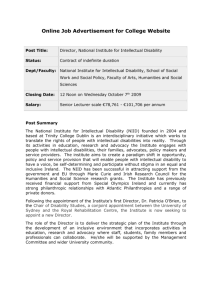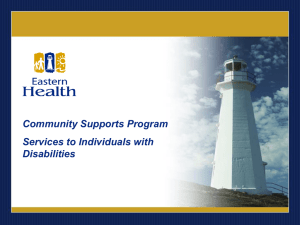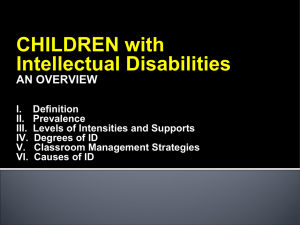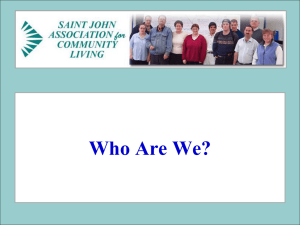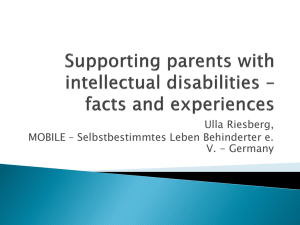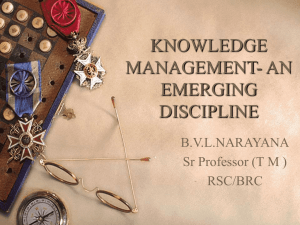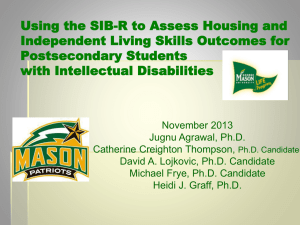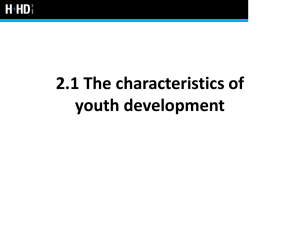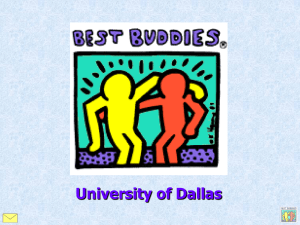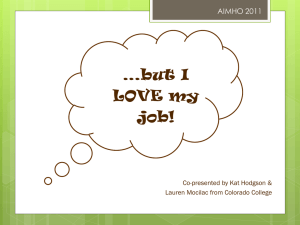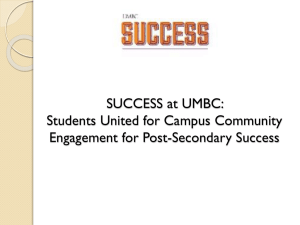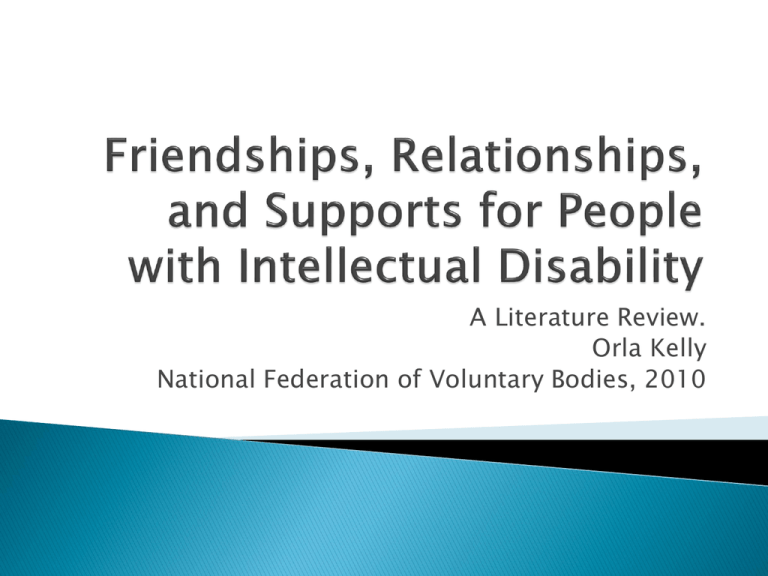
A Literature Review.
Orla Kelly
National Federation of Voluntary Bodies, 2010
Themes
Social Exclusion – Social Inclusion
Institutionalisation Vs Community Living
Construct of Disability?
Methodology
What matters?
People with intellectual disabilities are not easily
developing relationship networks
(Whitehouse et al, 2001; McVilly et al, 2006)
People with intellectual disabilities understand the
importance of satisfying relationships to the quality
of life and their social status but many do not
participate
(Chapell, 1994)
People with intellectual disabilities have very few
meaningful relationships with people who do not
have intellectual disabilities, are not relatives, and
who are not paid to support them
(Robertson et al, 2001)
Meaning of Friend:
•
A pivotal relationship
A pervasive part of a person’s life
A sense of shared history
An opportunity to share common interests
A reliable but reciprocal source of support
Maintaining a Friend
•
•
•
•
•
•
•
•
•
Making arrangements
Balancing other relationships
Remembering and reminiscing
Opportunities for autonomy
Living arrangements
(Knox et al, 2001)
•
•
•
•
Meaning of a Boyfriend/Girlfriend:
Characteristics of a boyfriend/girlfriend
Feelings of Intimacy
Physical Attractiveness
An expectation of relationship change
Maintaining
•
•
•
a Boyfriend/Girlfriend
Dating
Spending time alone
Planning for the future
(Knox et al, 2001)
Social
Exclusion
•Not being Listened to
•Having No Friends
•Finding it Difficult to do the things that People
without Intellectual Disabilities do
•Being made that they have no Contribution to
make, they are a Burden
•Feeling Unsafe, being Harassed, and Bullied
•Not having Control over Spending Money, not
having Enough Money
Morris, 2001.
Social
Inclusion
•Require more than just
placing people in proximity
to others.
•Means a sense of belonging
that is fostered through the
development
of
Valued
Relationships
Pockney, 2006.
Institutionalisation
•Segregation
•‘Distinct Social Space’
•Friendships with People
With Intellectual Disability,
Carers, Family .
•Asexual.
Community
Living
•Segregation
•‘Distinct Social Space’
•Friendships with People
With Intellectual Disability,
Carers, Family .
•Community Presence
•May have Sexual Identity
People With
Intellectual
Disability
Staff &
Families
Community
Integration
Service
Delivery &
Priorities
People With
Intellectual
Disability
A Lack of Social Skills
Behaviour & Communication Difficulties
(Forrester /Jones et al, 2006)
Development of Social Skills & Behaviour
Sex Education based on Biology, (Chivers et al, 2000)
Friendships for people with intellectual
disabilities appear to count for little in the
estimation of those who control their lives
(Emerson & McVilly, 2004)
Staff felt that they needed to retain a
degree of power if they were to
adequately protect and provide (Pahl et al,
2000)
Staff fear of favouring one person over another
– professional distance (Pockney, 2006)
Staff &
Families
Tasks need to be done
(Clement et al, 2009)
Parents hold more conservative views relating
to sexuality than staff (Cuskelly & Bryde, 2004)
Staff do not feel confident working with
gay/lesbian/bisexual (Abbott & Howarth, 2006)
Need for training, education and more
information
Staff &
Families
Examples of how Staff & Family support Friendships:
•Finding their Friends Phone Numbers
•Having Support to Exchange Cards at Birthdays
•To initiate contact and extend invitations
•Help identify Train and Bus routes
(McPilly et al, 2006)
Staff &
Families
Economic, lack of transport, cuts in services, lack of access to
one’s money, organisation of staffing, poor access to resources,
lack of autonomy, lack of privacy, personal info brought into
public domain, residents publicly disciplined (Abbott & McConkey,
2006; Chappell, 1994)
Barriers to making and maintaining friendships and relationships:
Service
Delivery &
Priorities
Positive outcomes derive from the absence of the overt
subordination of residents to staff (Randell & Cumella, 2009)
Need to listen to what people with intellectual disabilities want
(Miller, 2008)
Need to intervene at a systems level
(Emerson et al, 2004)
Service
Delivery &
Priorities
In times of spending restraint: 3 service goals to help focus
costs on things that matter
Need to maintain or improve 1. good conditions of life
2. each person’s happiness
3. the ways people have of becoming enabled to lead fulfilling
lives of their own choosing
(Brown, 1999)
Service
Delivery &
Priorities
Mere community presence does not result in
integration into the community (McVilly et al, 2006)
Community
Integration
There needs to be an opportunity for social
interaction – community activities around
socialisation (Kampert & Goreczny, 2005)
There needs to be an examination of the
importance placed on organisational tasks over
a ‘focused effort’ for community participation
(Clement & Bigby, 2008)
People With
Intellectual
Disability
Community
Integration
Control
Service
Delivery &
Priorities
Staff &
Families
The power that service workers have
to support, enable or actively destroy
an individuals relationships cannot be
ignored (Knox & Hickson, 2001)
We need to listen to what
people want for themselves
(Miller, 2008)
Control needs to be relinquished and
people with Intellectual Disabilities
need to be supported to take up this
control
Control
We need to “allow” people
with Intellectual Disabilities
to put their own meaning
on friendship and how they
wish to maintain them
(Knox & Hickson, 2001)
We need to understand the importance of our
friendship as staff members to people with
Intellectual Disabilities and not devalue it
People With
Intellectual
Disability
Community
Integration
Control
Service
Delivery &
Priorities
Staff &
Families
Social Network Guide
(Forrester-Jones, 2006)
Ethnographic Observations
Randell & Cumella, 2009)
Longitudinal Study
(Jahoda et al, 2009)
Quality of Life Questionnaire
(Miller, 2008)
The Social Support Self Report
(Lippold et al,2009)
The Social Inclusion Interview Schedule
(Pawson et al,2005)
Personal Outcome Measures
(McCormack et al,2009)
Workshops and Group Discussions
(Abbott & McConkey, 2006)
Six Session Programme – Linking feelings with personal relationships
Participatory Research where consent was ongoing
The Loneliness Scale
The Roommate Friendship Scale
Sexual Attitudes Questionnaire (Grieve et al,2008)
Sexual and Mental Retardation Attitudes Inventory
The Perception of Sexuality Scale
SexKen-ID
Assessment of Sexual Knowledge
(Jobling et al, 2000)
(Knox et al, 2001)
(McVilly et al, 2006)
(Wiltz et al, 2003)
(Bazzo et al, 2007)
(Swango-Wilson,2008)
(McCabe et al, 1999)
(Galea et al, 2004)
“Ultimately, it is not citizenship, but friendship
that matters”
(Reinders, 2002)
“What aspects of peoples lives facilitate or
hinder friendships and participation in
activities with friends”
(Emerson, 2004)

